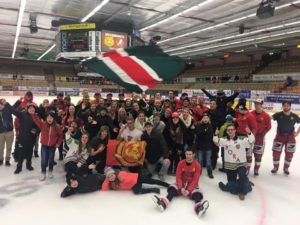Blizzy-Blog
Monday, January 16th:
I’ll have some Mora That
Lukas Hanson and Isaiah Welckle
Spirits where high after a great couple of days in Lillehammer full of skiing, dog sledding, and learning about the olympics. Now we are back out on the road, this time heading to Mora, Sweden. Norway treated us well and we are sad to be leaving such a great country. To start the day we had the usual breakfast consisting of the fantastic spread of various eggs, meats, fresh veggies, fresh fruits, pastries, and breads. The road to Mora is long, we are looking at a five hour ride. Word is Kate has lots of fun games prepared for the trip so it will fly by.
The bus ride started with two great presentations giving the group a little bit of needed insight about Swedish culture before we arrive. Will Jones and Alec Overland (pictured below) gave their class session on the Dalahäst of Sweden and the Vasalopet race.
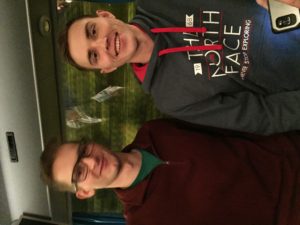
For those who are not familiar they are small wooden painted horses. The tradition started from men carving small wooden animals during their free time and giving them to their children to play with. Horses ended up being the most popular to play with, weird we thought the muskrat would be a shoe-in for most popular. The horses became world famous in 1939 when a giant 6 meter tall Dalahäst wowed patrons at the New York World Exhibition. We learned that there are two main families/companies that are producing these horses today. They are the Grannas Olsson, which is the oldest, and not far behind is the Nils Olsson family. The horses are known for their distinct look. The horses are painted red because red was the most accessible color of the time. The ripple pattern is the most difficult part and takes years of practice to perfect. The second part of this class was done on the Vasaloppet, the oldest, longest, and most highly participated in cross country skiing race in the world. It is truly a grand spectacle. The race starts in Sälen, Sweden and works its way through seven towns before it ends in Mora, Sweden. The tradition of the race came from a story about a Swedish hero, Gustav Eriksson Vasa who escaped a Danish massacre of Swedish magnates. He skied his way through the seven towns alerting towns folk and rallying support for a Swedish rebellion. He eventually successfully led the Swedish rebellion and helped Sweden gain independence from Denmark. He became the first king of Sweden. Fun Fact Alert: Gustav Eriksson Vasa is actually the grandfather of one Gustavus Adolphus. Pretty cool connection. The race has seen some great competition and the record time is 3 hours 38 minutes and 11 seconds. That’s extremely fast considering the race is 94 kilometers.
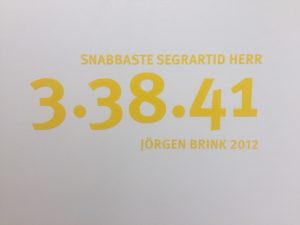
The second class period of the bus was presented by Nate Defoe and Maggie Nelson (pictured below).
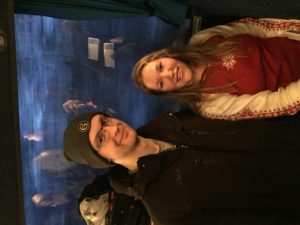
They gave the class some great insight and overview about Swedish culture. Sweden and Norway are split by the Skanderna mountain range. 50% of Sweden is covered in forest, which will make this a beautiful bus ride. Sweden is home to the lowest income inequality in the world, which is due in part to their basic principle of “lagom”. This is the idea that everyone should have just enough for their basic needs. Word is that the best sales occur after Christmas into and through January. So we are expecting to be pushing the weight limits of or checked luggage on the way home. Expect souvenirs. The class concluded with some basic Swedish phrases like hello (hay), thank you (tack), and goodbye (hej då). The most important phrase we leaned was Kommer du hit ofta? Meaning “do you come here often?” This might come in handy for the single members of the trip.
Now we sit back and enjoy the Norwegian and Swedish countryside. After a few quick stops to stretch our legs and get some fresh air we arrived in Mora at the folk school. There were some great sights to be seen the snow covered mountains and trees may never get old to look at.

There we received a warm welcome from a current student (Johanna) at the school and a sign that welcomed Gustavus Adolphus College. Johanna gave the group a short introduction to the school that would be built upon later. Lunch was what was on the mind of the whole group, it had been a long trip. Lucky for us lunch was ready and delicious. It was our first meal in Sweden so naturally we had Swedish meatballs. The meal had to be quick because we were in store for a talk at a he vasalopet museum.
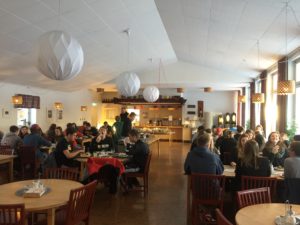
We swiftly made our way over to the Vasalopet museum. The museum was small and hard to classify as a museum even. There was one main area with the shortened version of the history of the race. They are in the process of remodeling the museum so we are thankful that they opened their doors to us. We received a short introduction to the Vasalopet ending in Mora. We learned that the first race was held in 1922 but the history of the race goes back to the 1520’s as we mentioned earlier. The Vasalopet is not the only race that the Vasalopet company puts on over the course of the year. They hold various different ski races of differing lengths. They are even adding a new race this year that is skied overnight. The fun isn’t just contained to the winter. There are summer running and biking races. None of their other races are as big as the Vasalopet but none of them could be done without the help of their volunteers. The large race has around 5,000 volunteers. Theses people are generally members of their local sporting clubs, usually the IFK Mora club or the Sälen Club. These clubs support the local athletics and sponsor a range of different sports. Anders Pers was the founder of the official Vasalopet race which was run March 19th 1922. The race had 119 participants and came off as a huge success. It had grown to be the Swedish Super Bowl where most families wake up early to watch the whole race, which is usually around 4-6 hours. The winner of the race has wreath placed on their head as they cross the finish line by a female member of the Mora Sports Club who is dressed in traditional clothing. Sort of a fun connection to the town. It was fun to learn about the race and to find out that is such an important part of Swedish culture and the history of Mora. The Lopet held in the sister city of Mora, Minnesota is nowhere near as large or important, but it is a fun connection.
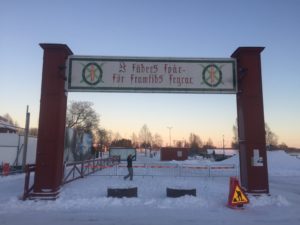
(The finish line of the Vasalopet in Mora)
After this the group went back to the Mora Folk school to catch up with some current Gustavus students who are studying abroad at the school and to learn more about how the school works. The school has around 150 students. It is required by law to have a general liberal arts curriculum to receive funding from the government. In addition, they have curriculum that is a liberal arts with a focus on learning Swedish. This is good for immigrants. They have a course that is 100% dedicated to skiing, where the students train and ski all day. They have a design program for student to really hone their design skills. They have a program dedicated to learning about working with and around people with autism. The school is essentially an alternative school for people who felt left behind in the traditional school or didn’t fit in well, or even students who have had troubles due to a change in their personal life. The school was also described as a bit of second chance opportunity for students. The age range there was very wide with students as old as 70 but the vast majority are college aged. The school is focused on a specific style of learning that is based on dialogue. The goal is for every student to become comfortable and capable at formulating opinions and speaking their mind effectively. They do not have traditional homework or tests. They believe that this reduces the stresses that students encounter that could inhibit their learning. They have no set curriculum so it makes for and adaptable and fluid style of learning. There is really nothing in the United States that is comparable to this school so it makes it hard to really understand it’s value. Parts of the school make it a bit like a technical college where students can go to learn a specific skill to be applied to a job. In other ways it’s like a junior college where students can become comfortable with school again and get a general education before heading to university. Then there are parts where it seems like an adult community education course where class is held once a week, like tonight’s self defense course for instance. We thought that this was a really interesting style of schooling that proved to have a lot of benefits, like being available for students with autism or ADHD who struggle with traditional methods. It’s great because it provides a good education that can be as specific or general as the student wishes. One really great aspect was the Swedish language part that allows immigrant to learn the language and he culture for free. This is incredibly helping for getting people up on their feet in a new country, giving them the skills they need to get a job and become accustomed. This would be great in the United States. The problem we saw was funding. The Mora Folk School and all other schools like it are funded through the Swedish government either national, local, or both. This can be done because Sweden has the third highest tax rate in the world. The US governments wouldn’t be able to adequately fund theses and new immigrants wouldn’t be able to pay much for school. This presents a problem. The other issue we saw was that this is a stepping stone to university in Sweden but we aren’t sure it would be as effective in the united states where school is based heavily on tests and homework. How would students adapt? Not well we think.
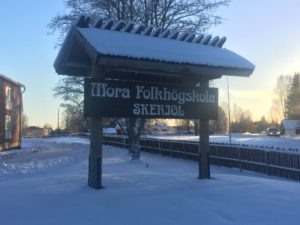
To cap off the evening many of the group went to a Mora hockey game. This team is on the second level of Swedish professional hockey. They had a great atmosphere at this game, unlike anything any of us had ever seen for a Monday night game against one of the bottom teams in the league. Our group sat right behind the main cheering section of the club. They had a drummer and a leader getting the fans riled up. Our group bought in hard. We loved it and they loved our enthusiasm. So much so that they invited us down onto the ice after the 7-0 victory. We got pictures and chatted with some of the players. We found out that this team is on first place in their league with 17 games to go. If they can remain in first they will be moved up into the top Swedish professional hockey league next season. This was a great way to cap off a day that didn’t hold tons of excitement like yesterday did.
